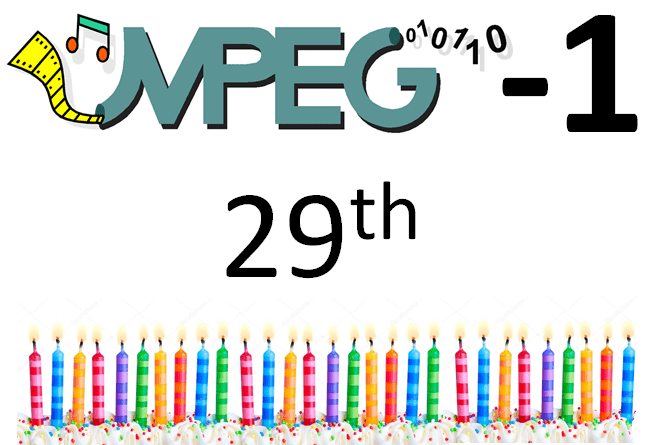For the first 10 years, the cadence of MPEG meeting was March-July November. In addition to these 3 meetings per year, a number of other meetings were added to cope with the hectic rhythms of development of the first standards. The total number of meetings was 43, which makes about 4 meetings a year. If we consider that MPEG had 130 meetings, i.e., 32 years, until its end in 2020, the average meeting frequency remained constant at 4 per year. So the pace of development of MPEG standards kept on being hectic :-). This does not include the ad hoc group meetings. In the early days of MPEG I kept track of them, but eventually gave up. My estimate is that there were about 200-300 ad hoc group meetings in total.
It so happened that the first two MPEG standards – MPEG-1 and MPEG-2 – were approved in November. This November I want to celebrate the 29th anniversary of MPEG-1.
In the collective imagination, MPEG-1 is the younger and less famous brother compared to MPEG-2 with its towering importance. I am not going to make a competition between the two because all MPEG standards are my kids, but I should like to emphasise that MPEG-1 has several merits of its own.
- It was the first standard produced by a group that had come out of the physical nothing, saying something that by now no one world dispute but that until then no one had proposed, namely that digital media made sense a lot of sense for entertainment and little sense for communication. Of course the consumer electronic industry was very keen on having digital media standards, but they were constitutionally unable to get together and agree on one. For the members of that industry, standards could only be the result of the ratification of a proprietary product blessed by market success.
- Therefore the second merit of MPEG-1 was that, in spite of not having a constituency, actually, having one “against”, MPEG could see the light, thrive and produce standards. Mind you, these things never “happen”. They are made to happen and very often there are many “midwifes”. In the case of MPEG, this is an initial list.
- I was one. I never told the story of the little effort that I put into MPEG. Maybe one day I will do it.
- Another was Cesare Mossotto, the director of CSELT (when it was still in existence, it was the research centre of Telecom Italia). Cesare, in spite of having spent a sizeable part of his professional life in ITU-T working on signalling, supported me (I dare not say that at the beginning he believed in the success of the enterprise I had undertaken).
- Still another was Hiroshi Yasuda of NTT who, was the founder and chair of JPEG and offered a cradle to the infant MPEG. Hiroshi also played an important role when he defended MPEG against “Herod” who had taken the form of Roland Zavada of the then all-powerful (in the still and moving image space) Kodak and chair of a high-level ISO group coordinating image-related matters. Rollie had come to “inspect” this unheard-of group of experts dealing with Moving Pictures – which he had taken to mean Motion Pictures – with a membership growing at every meeting like mushrooms.
- A sizeable part of the group of people attending the COST 211 group, a European collaborative project that had started with the goal of a 2 Mbit/s videoconference standard, which was at least curious of this unexpected group and added momentum.
- Some friends at COST 211 and a few others joined the ESPRIT COMIS (COding of Moving Images for Storage) project that I launched to support the MPEG-1 standardisation project and promote its exploitation by the European industry.
- The third merit was to handle digital media as opposed to handling video and audio, digital or otherwise. Today people take it for granted that media have to be managed in a unitary fashion, but at that time, in companies and standards bodies alike, audio and video were in separate, sometimes remote, departments. In ITU-T they were even in different Study Groups and in IEC in different Subcommittees.
- The fourth merit was to effect a generation change in media transport technologies. When the ITU-T developed the videophone multiplexer it used technologies – Frame, Multiframe, Supermultiframe – that had their origins in the 1960’s when the digital speech multiplexers were investigated. MPEG-1 adopted a modern packet multiplexer that eventually influenced the MPEG-2 Transport and Program Stream and laid the foundations of such big results as DASH and CMAF.
- The fifth merit was to be the first digital media standard to have mass-market impact. Of course ITU-T G.711 (digital speech) and Red Book compact disc (digital audio) had an enormous impact, but they “just” digitised the analogue speech and audio signals (that was a big thing, though). ITU-T H.120 (the standard that ratified the COST 211 codec) and H.261 did apply compression (to make what I call digital media), but the total number of pieces of the former is less than 100 and I doubt that the total number of the latter is more than 1.000. About 1,000,000 Video CD players, that use MPEG-1 Video and MPEG-1 Audio Layer II (MP2), were sold.
- The sixth merit was to use digital technology not just for the purpose of making better what was already good, but to make innovative use of digital media. When MPEG approved MPEG-1 on the 2nd of November 1992, there were people still objecting to making a standard of such a complex audio coding like MPEG Audio Layer III, aka MP3. They had their own agenda, but they were right. While MP2 had a preferential route to DAB (Digital Audio Broadcasting) product which implied changing the broadcast infrastructure, MP3 had a hard time to emerge. Until, I mean, a software codec was developed and spread like wildfire. It changed an infrastructure – record distribution – and humans’ relationship with music forever.


